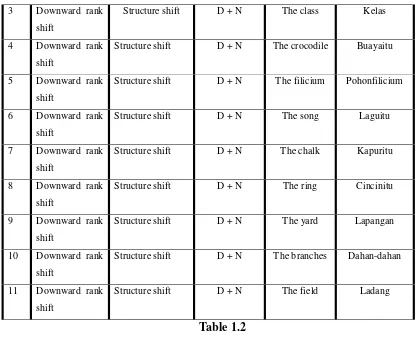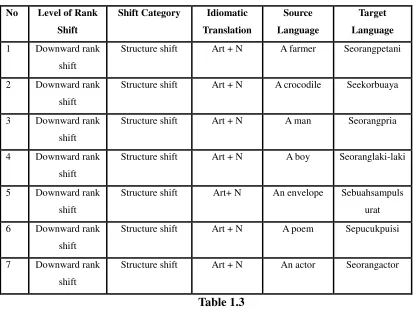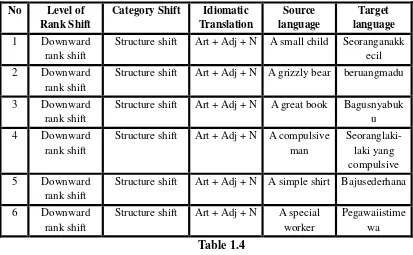CHAPTER IV
FINDINGS AND DISCUSSION
This chapter describes two main topic, they are data description and data analysis. The data was taken in this study are type of translation and shift of translation in the Rainbow Troops novel. The writer does not analyze the entire sentence, but the writer describes of noun phrase in the novel. The analysis of the study based on the problems in chapter I.
A. Data Description
In this data description, it has classified data which are taken from the novel.
Table System Idiomatic Translation of Rank Shift of Noun Phrase in“Rainbow Troops”
No Level of Rank Shift
Shift Category Idiomatic Translation
Source Language
Target Language 1 Downward rank
shift
Structure shift P + N His father Ayahnya
2 Downward rank shift
Structure shift P + N His family Keluarganya
3 Downward rank shift
Structure shift P + N His eyes Matanya
4 Upward rank shift
Structure shift P + N His child Anaknya
5 Downward rank shift
Structure shift P + N His face Wajahnya
6 Downward rank shift
Structure shift P + N My legs Kakinya
7 Downward rank shift
Structure shift P + N My body Tubuhku
8 Upward rank shift
Structure shift P + N My sound Suaraku
9 Downward rank shift
Structure shift P + N My village Desaku
Table 1.1
Based on the data, the writer found some words from the same system of idiomatic translation.
His fatherwasn’t wearing shoes and had on cheap cotton pants.
His father had bought him the wrong kind of pencil.
From the examples above the noun phrase “his father” in source language becomes “ayahnya” into target language. The target language follows the system of the source language. It means that the Indonesian language adopt the source language.
His eyes lit up as they glanced animatedly around the room.
His eyes were titled upwards like sword blades and his eyebrows were
virtually.
The noun phrase “his eyes” in source language become “matanya and bola matanya” in the target language. There are differences both of source language and
target language in the meaning from the examples. So the translator should be appropriate between the source language and target language.
No Level of Rank Shift
Shift Category Idiomatic Translation
Source Language
Target Language 1 Downward rank
shift
Structure shift D + N The parents Para orang tua
2 Downward rank
shift
3 Downward rank
shift
Structure shift D + N The class Kelas
4 Downward rank
shift
Structure shift D + N The crocodile Buayaitu
5 Downward rank
shift
Structure shift D + N The filicium Pohonfilicium
6 Downward rank
shift
Structure shift D + N The song Laguitu
7 Downward rank
shift
Structure shift D + N The chalk Kapuritu
8 Downward rank
shift
Structure shift D + N The ring Cincinitu
9 Downward rank
shift
Structure shift D + N The yard Lapangan
10 Downward rank
shift
Structure shift D + N The branches Dahan-dahan
11 Downward rank
shift
Structure shift D + N The field Ladang
Table 1.2
Based on the data above the writer found some words from the same system of idiomatic translation.
The crocodile of the Butariver had strange disposition.
The crocodile submitted to him.
From the examples, each noun phrase has different meaning although same words. So the meaning of noun phrase should appropriate with context meaning in the sentence.
No Level of Rank Shift
Shift Category Idiomatic Translation
Source Language
Target Language 1 Downward rank
shift
Structure shift Art + N A farmer Seorangpetani
2 Downward rank
shift
Structure shift Art + N A crocodile Seekorbuaya
3 Downward rank
shift
Structure shift Art + N A man Seorangpria
4 Downward rank
shift
Structure shift Art + N A boy Seoranglaki-laki
5 Downward rank
shift
Structure shift Art+ N An envelope Sebuahsampuls
urat
6 Downward rank
shift
Structure shift Art + N A poem Sepucukpuisi
7 Downward rank
shift
Structure shift Art + N An actor Seorangactor
Table 1.3
No Level of Rank Shift
Category Shift Idiomatic Translation
Source language
Target language
1 Downward
rank shift
Structure shift Art + Adj + N A small child Seoranganakk ecil
2 Downward
rank shift
Structure shift Art + Adj + N A grizzly bear beruangmadu
3 Downward
rank shift
Structure shift Art + Adj + N A great book Bagusnyabuk u
4 Downward
rank shift
Structure shift Art + Adj + N A compulsive man
Seoranglaki-laki yang compulsive
5 Downward
rank shift
Structure shift Art + Adj + N A simple shirt Bajusederhana
6 Downward
rank shift
Structure shift Art + Adj + N A special worker
Pegawaiistime wa
Table 1.4
Based on the data above, the writer classified same words in the source language but different meaning into target language. All of the same system of idiomatic translation can be different meaning in the target language. For example a great book, a compulsive man.
No Level of Rank Shift
Category Shift Idiomatic Translation
Source Language
Target Language
1 Upward rank
shift
Structure shift Det + N + C +
Det + N
The children
of the
fisherman
Anak-anaknelayan
2 Upward rank
shift
Structure shift Det + N + C +
Det + N
The son of the
fisherman
Anakdarinelayan
3 Upward rank
shift
Structure shift Det + N + C +
Det + N
The son of the
businessman
Anakdaripengusaha
rank shift Det + N animals
5 Downward
rank shift
Structure shift Det + N + C +
Det + N
The yard of
home
Halamanrumah
Table 1.5
Based on the data above, the writer classified same words in the source language but different meaning into target language. All of the same system of idiomatic translation can be different meaning in the target language. For example a great book, a compulsive man.
No Level of Rank Shift
Category Shift Idiomatic translation
Source Language
Target Language
1 Upward rank
shift
Unit shift Det + N + C +
Det + N
The branches
of the filicium
Batangpohonfilicium
2 Upward rank
shift
Unit shift Det + N + C +
Det + N
The branches
of the batan
Batangpohonbatan
3 Upward rank
shift
Unit shift Det + N + C +
Det + N
The rim of the
roof
Lingkarangdariatap
4 Upward rank
shift
Structure shift Det + N + C +
Det + N
The tips of the
filicium
Ujung pohonfilicium
5 Upward rank
shift
Structure shift Det + N + C +
Det + N
The driver of
the DKW
Sopir DKW
Table 1.6
B. Discussion
In the discussion, the writer will explain the data was taken from”Rainbow Troops” Discussion
1) SL: The branch of an old filicium tree shaded me.
TL: Sebatangpohonfiliciumtua yang rindangmeneduhiku.
It can be seen above that the English noun phrase is translated into a clause in target language. The noun phrase “the branch of an old filicium tree”, here source language has constitution of definite determiner (the) + noun phrase (of an old filicium tree). The determiner is not translated. The noun phrase “the branch of an old filicium tree” is then constituted by noun (branch) + noun phrase (of an old filicium
tree). The conjunction is not translated, and then noun phrase is constituted article (a)
2) SL: His father was no wearing shoes and had on cheap cotton pants. TL: Ayahnya itu tak beralas kaki dan bercelana kain belacu.
It can be seen above that the English noun phrase is translated into noun phrase also in the target language. The noun phrase in the source language text has constitution of pronoun (his) + noun (father). The noun phrase is also translated into noun phrase in the target language which is constituted out of noun phrase (ayahnya).
Such kind of shift namely structure shift. This shift in translation occurs because in bahasa Indonesia as the target language. The noun phrases in English are have a different structure.
3) SL: The parents patted him on the back to console him.
TL: Para orangtua menepuk-nepuk bahunya untuk membesarkan hatinya.
It can be seen above that English noun phrase is translated into noun phrase also in target language. The noun phrase in the source language text has constitution of determiner (the) + noun (parents). The noun phrase is also translated into noun phrase in target language which is constituted out of (paraorangtua). Such kind of shift namely structure shift. This shift in translation occurs because in Bahasa Indonesia as the target language. The noun phrases in English are a different structure.
4) SL: His clothes and hair style were very neat. TL: Pakaian dan rambutnya sangat rapi.
in target language. The noun phrase in the source language text has constitution of pronoun (his) + noun (clothes and hair style). The noun phrase is also translated into noun phrase in target language which is constituted out of (pakaiandanrambutnya).
Such kind of shift namely structure shift. This shift in translation occurs because in Bahasa Indonesia as the target language. The noun phrases in English are a different structure.
5) SL: The young teacher’s tears subsided. TL: Air mata guru muda ini surut.
It can be seen above that English noun phrase is translated into noun phrase in target language. The noun phrase in source language has constitution of determiner
(the) + noun phrase (young teacher’s tears). The noun phrase is translated into noun phrase in the target language has adjective phrase (young) + noun (teacher’s tears). This translation shows that there is the occurrence of translation shift in this data in which “young” in the source language text which is adjective phrase. Such kind of shift namely structure shift. This shift in translation occurs because in Bahasa Indonesia as the target language, we cannot put in translation into “young” since the
6) SL: His eyes lit up as they glanced animatedly around the room. TL: Bola matanyabergerak-gerakcepatdanmenyala-nyala.
It can be seen above that the English noun phrase is translated into noun phrase also in the target language. The noun phrase in the source language text has constitution of pronoun (his) + noun (eyes). The noun phrase is also translated into noun phrase in the target language which is constituted out of noun phrase (eyes).
Such kind of shift namely structure shift. This shift in translation occurs because in bahasa Indonesia as the target language. The noun phrases in English are have a different structure.
7) SL: We did not blink watching this magnificent story teller.
TL: Kami tidakberkedipmenatapsang jurukisahulungini.
It can be seen above that noun phrase is translated noun phrase into target language. The noun phrase has constitution determiner (this) + noun (magnificent story teller) in target language. The article is not translated. Then noun phrase “magnificent story teller” is then constituted by adjective (magnificent) + noun (story
teller). In target language, the noun phrase has constitution of only noun phrase (sang jurukisahulung). Moreover, it can be conclude that information of definite determiner
English and bahasa Indonesia.
8) SL: There was a beauty in this poor school. TL: Ada keindahandisekolahislammelaratini.
It can be seen above that the English noun phrase is translated into a word in the target language. The noun phrase “a beauty” has the constitution of article (a) + adjective (beauty). Meanwhile in the target language text, it becomes a word
(keindahan). Therefore, it is known that the translation shift occurs in this data, because the noun phrase in the source language text is translated into a clause in the target language text. This type of shift is called intra system shift. There is no loss or gain of information in this translation.
9) SL: He was a farmer.
TL: Seorangtionghoapetani.
linguistic system between English and Bahasa Indonesia.
10)SL: Tarpani was talking about a great book,tenggelamnyakapal van der wijk-Hamka’s legendary literary piece.
TL: Tarpaniberceritatentangbagusnyabukutenggelamnyakapal van der wijkkaryaHamka.
It can be seen above that the English noun phrase is translated into a clause in target language. The noun phrase “a great book”, here source language has constitution of definite article (a) + noun phrase (great book). Then, the noun phrase constituted as adjective (great) + noun (book). The article is not translated. Moreover, it can be concluded that information of definite article is translated into target language. Because it still understandable by the reader. In addition, the source language will be ambiguous, because the translation becomes “bagusnyabuku”. This rank shift is called the structure shift. Although, the noun phrase in the target language is also translated into the noun phrase in source language. This structure shift happens due to different linguistic system between English and bahasa Indonesia.
11)SL: My legs failed around hopely. TL: Kakikumengais-ngaisputusasa.
of definite pronoun (my) + noun phrase (legs). Moreover, it can be concluded that information of definite determiner translated into target language. Because it still understandable by the reader. In addition, the target language becomes “kakiku”. This rank shift is called intra system shift. Although, the noun phrase in the target language is also translated into the noun phrase in source language.
12)SL: The crocodile submitted to him. TL: Buayaitusepertitakluk.
It can be seen above that the English noun phrase is translated into noun phrase in target language. The noun phrase “the crocodile”, here source language has constitution of definite determiner (the) + noun phrase (crocodile). The determiner is translated also. Moreover, it can be concluded that information of definite conjunction is not translated into target language. Because it still understandable by the reader. This rank shift is called the structure shift. Although, the noun phrase in the target language is also translated into the noun phrase in source language. This structure shift happens due to different linguistic system between English and Bahasa Indonesia.
13)SL: He was like the wind.
TL: Iasepertiangin.
constitution of definite determiner (the) + noun phrase (wind). The determiner is not translated. Moreover, it can be concluded that information of definite determiner translated into target language. Because it still understandable by the reader. This rank shift is called the structure shift. Although, the noun phrase in the target language is also translated into the noun phrase in source language. This structure shift happens due to different linguistic system between English and Bahasa Indonesia.
14)SL:The house was shack on stilts, in case the sea rose too high.
TL:Gubukituberatapdaunsagudanberdindinglelakdarikulitmeranti.
It can be seen above that the English noun phrase is translated into noun phrase in target language. The noun phrase “the house”, here source language has constitution of definite determiner (a) + noun phrase (house). The determiner is not translated. Moreover, it can be concluded that information of definite determiner translated into target language. Because it still understandable by the reader. This rank shift is called the structure shift. Although, the noun phrase in the target language is also translated into the noun phrase in source language. This structure shift happens due to different linguistic system between English and Bahasa Indonesia.
15)SL:I tired hard to improve my sound.
TL:Akuberusahamemperbaikiintonasilagu.
of definite pronoun (his) + noun phrase (sound). Moreover, it can be concluded that information of definite pronoun is translated into target language. Because it still understandable by the reader. In addition, the source language will be ambiguous becomes “memperbaikisuaraku”, but in target language becomes “memperbaikiintonasilagu”. This rank shift is called the structure shift. Although, the
noun phrase in the target language is also translated into the noun phrase in source language. This structure shift happens due to different linguistic system between English and bahasa Indonesia.
16)SL:The song crept over the old wooden walls of our school.
TL:Laguitumerambatidindingpapantuakelas kami.




